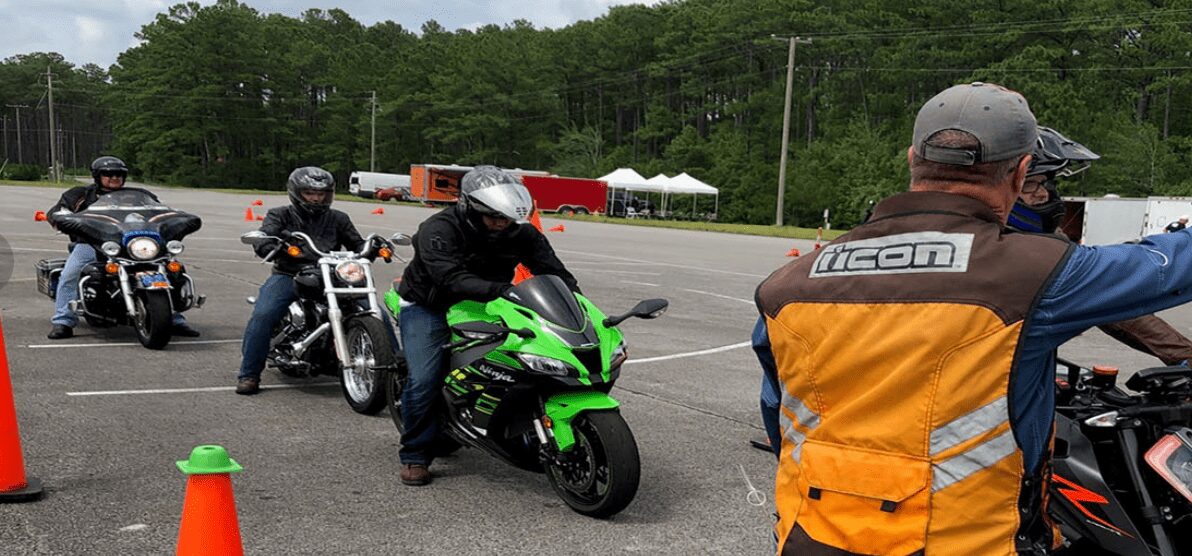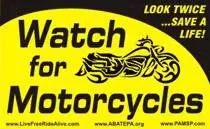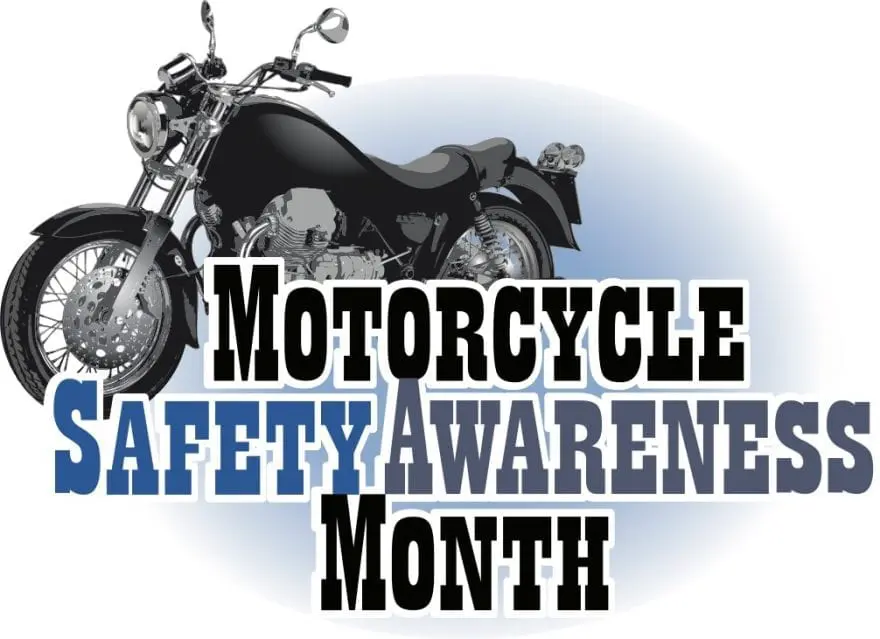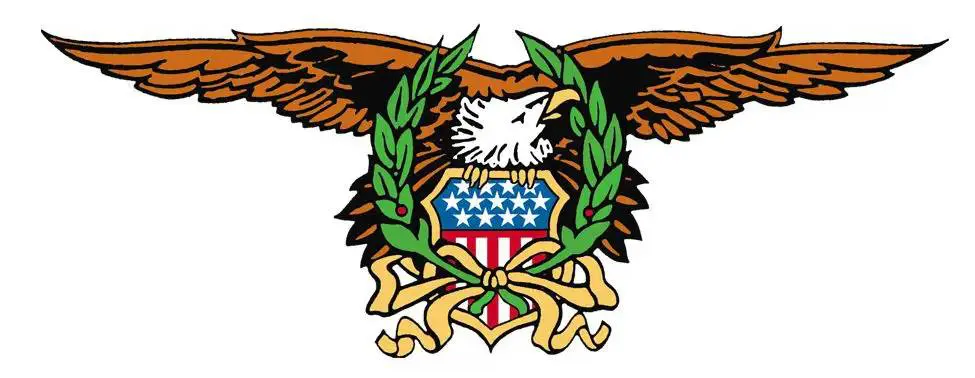safety & awareness education
 Operation Save-A-Life is a motorcycle awareness program intended for school and civic groups. OSAL's goal is to teach automobile drivers to be alert to motorcycle operators on the highways with the aim of helping everyone to "share the road" safely.
Operation Save-A-Life is a motorcycle awareness program intended for school and civic groups. OSAL's goal is to teach automobile drivers to be alert to motorcycle operators on the highways with the aim of helping everyone to "share the road" safely.
The presentation consists of one or two videos, safety tips and a question-and-answer session presented by speakers provided FREE of CHARGE by A.B.A.T.E. of PENNSYLVANIA.
Operation Save-A-Life is approved by the Pennsylvania Departments of Transportation and Education for use in driver education programs throughout the state.
Top Ten Ways to Drive AWARE!
- You can drive aware of motorcycles, if you know what to expect from motorcyclists and the situations where accidents are likely to occur.
- Look out for motorcyclists. Be aware that although you may not see any cars, there may be an unnoticed motorcycle. Be careful at intersections, particularly when making left turns.
- Anticipate a motorcyclist’s maneuvers. Motorcyclists may change positions in the lane to better observe traffic flow, respond to road conditions, get motorist’s attention and other factors. Expect and allow room for such conditions.
- Signal your intentions, even if you don’t see cars in front or behind you. Again, be particularly careful when making left turns across lanes of approaching traffic. Look carefully in all directions for approaching motorcyclists –"Look Twice, Save-A-Life!"
- Respect motorcyclists’ rights to the road. Give motorcycles a full lane to maneuver, just as you would a vehicle.
- Do not tailgate a motorcycle. Motorcyclists may need to slow down quickly, swerve or change lane position to avoid gravel, rocks, oil slicks, animals and other road debris. Tailgating could lead to a severe accident or death of a motorcyclist. Keep a four second distance between you and the motorcycle.
- Drive aware of your surroundings. Motorists have a steel cage around them with four or more tires on the road. Motorcyclists are far more vulnerable to serious injury as a result of being in an accident with a motorist.
- Motorcycles are easy to maneuver. They can turn and swerve very well at slow speed. However, people think that they can get out of any situation. This is not so. Motorcycles traveling at highway speed are more difficult to maneuver in problem situations and, unlike motorists, require more concentration and coordination to be operated safely.
- Pay attention to the motorcyclist’s hand signals. Some motorcycles do not have self-canceling turn signals. Therefore, wait to see what the motorcyclist does before you make your move.
- Motorcyclists often ride in groups. When entering or exiting a highway and attempting to pass a group of motorcyclists, do not cut into the group unless the group has provided space for you. If there isn’t any space, let the group pass the exit before making your move. And when passing a group, make sure you can safely pass the whole group or move into the space provided for you!
Why Be Aware of Motorcyclists?
- The failure of motorists to detect motorcycles is the most frequent cause of accidents for motorcyclists. More than one half of motorcycle accidents occur because the driver simply "did not see the motorcycle coming."
- Drivers also contribute to another 10% of motorcycle accidents where the motorcycle is the only vehicle involved. Drivers who unintentionally pull out in front of a motorcycle often force the rider to over brake, slide, and fall.
Why Don’t Drivers See Motorcyclists?
There are several reasons why drivers may not see the motorcyclist coming:
- Motorists tend to look for other cars, not motorcycles.
- Motorcycles have a smaller profile than larger vehicles. This makes an approaching motorcyclist harder to see, and estimating the distance and oncoming speed is more difficult.
- Motorists have "blind spots" in their vehicles such as mirrors and posts between doors and windows that could obstruct their vision of motorcycles.
- Also, everyone has a blind spot in each eye where a motorcycle could be "hiding."
What Are the Situations When Accidents Are Most Likely to Occur?
Accidents are most likely to occur in these high-risk situations:
- Left Turns: The most common accident between cars and motorcycles is at an intersection when the automobile driver is making a left turn in front of a motorcycle. Over 40% of all motorcycle accidents occur at intersections.
- Obstruction of View: Cyclists riding alongside a lane of cars are often out of the view of the driver. An unsuspecting driver may collide with a motorcyclist as the driver tries to change lanes.
- Hazardous Road Conditions: Motorcyclists have to be much more concerned about road surfaces than motorists do. Although road obstructions such as potholes, fallen tree limbs, or railroad tracks may be minor problems for drivers, a motorcyclist may have to slow down or change lanes to avoid these obstacles.
- Weather Conditions: When the road surface is wet or icy, motorcyclists’ braking and handling abilities are impaired.
- Strong Winds: A strong gust of wind can move a motorcycle across an entire lane if the rider isn’t prepared for it. Wind gusts from large trucks in the other lane can be a real hazard.
- Large Vehicles: A large vehicle, such as a van or truck, can block a cycle from a driver’s view. The motorcyclist may seem to suddenly appear from nowhere.
- Alcohol and Drugs: These substances will impair your vision, physical coordination, and timing. They will affect your judgement. Don’t use alcohol or drugs and drive.

Motorcycle Training Links and Info
Pennsylvania's Motorcycle Safety Program
The "Look Twice - SAVE A LIFE" Lawn Sign Campaign has generated substantial awareness of, and interest in (as reflected in radio, TV and newspaper coverage), the visibility and right-of-way issues facing motorcyclists.

We instruct our members to place the signs on more heavily traveled roadways for maximum exposure. With an increase in the number of new signs (plus those signs that have survived from previous years) our cost-per-thousand impressions statewide is dramatically less than any other form of advertising we have attempted (radio, print, billboards or TV).
Our "Look Twice - Save A Life" message is having an impact in improving motorcycle awareness and safety among the general motoring public and motorcyclists throughout Pennsylvania.


May is "Motorcycle Awareness Month"
The month of May has been designated Motorcycle Safety & Awareness Month for two decades. As temperatures warm and the presence of motorcycles increases, motorists and motorcyclists must unite in the safe sharing of roads throughout Pennsylvania.
"It's a reminder to motorists to be aware of motorcyclists", according to Charles Umbenhauer of ABATE. "It's also a reminder to motorcyclists to keep their equipment in shape, ride safely, and take advantage of the training offered by Pennsylvania's Motorcycle Safety Program."
Motorcycle riding is a popular form of recreation and transportation for 843,000 licensed motorcyclists across the Commonwealth.
